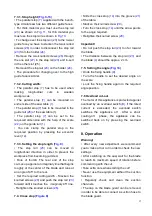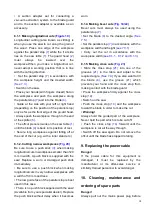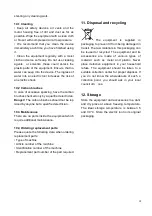
11
deformed saw blades.
–
Replace a worn table insert.
–
Only use saw blades recommended by the
manufacturer which conform to
EN 847-1.
Warning!
Keep attention When changing the
saw blade.The cutting width is not smaller
and the main blade thickness of the saw
blade is not greater than the thickness of the
gap wedge!
–
Make sure that a suitable saw blade for the
ma-terial to be cut is selected.
–
Wear
suitable
personal
protective
equipment. This includes:
Hearing protection to avoid the risk of
becoming hearing impaired,
Respiratory protection to avoid the risk of
inhal-ing harmful dust,
–
Wear gloves when handling saw blades
and rough materials.
–
Carry saw blades in a container whenever
practi-cal.
–
Wear goggles. Sparks generated during
work or splinters, chippings and dust coming
from the device can lead to loss of eyesight.
–
Connect a dust collecting device to the
electric tool when sawing wood. The emission
of dust is influenced, among other things, by
the type of material to be processed, the
significance of local separation (collection or
source) and the correct setting of the
hood/guide plates/guides.
–
Do not use saw blades made of high-speed
alloy steel (HSS steel).
–
In times of non-use keep the push stick or
the push block with the electrical power tool in
its holder at all times.
2. Maintenance and repair
–
Pull out the mains plug for any adjustment
or repair tasks.
–
The generation of noise is influenced by
various factors, including the characteristics
of saw blades, condition of saw blade and
electric tool. Use saw blades which were
designed for reduced noise development,
insofar as possible. Maintain the electric tool
and tool attachments regularly and if
necessary, initiate repairs in order to reduce
noise.
–
Report faults on the electric tool, protective
devices or the tool attachment to the person
responsible for safety as soon as they are
dis-covered.
3. Safe work
–
Use the push stick or handle with sliding
wood, to pass the workpiece securely out off
the saw blade.
–
Make sure that the riving knife is always
used, and set up is correctly.
–
Use the upper blade guard and set it to the
cor-rect position.
–
Only use saw blades for which the
maximum permissible speed is not lower than
the maxi-mum spindle speed of table saws
and which are suitable for the material to be
cut.
–
Do not cut rebates or grooves without fitting
a suitable guard, e.g. a tunnel-type guard,
over the saw table.
–
Circular saws must not be used for slotting
jobs (cutting grooves which end in the
workpiece).
–
When transporting the electric tool, only
use the transport devices. Never use the
protective devices for handling or transport.
–
Make sure that the upper part of the saw
blade is covered during transport, e.g. by the
protective device.
–
Be sure to only use spacers and spindle
rings specified by the manufacturer as
suitable for the intended purpose.
–
The floor around the machine must be level,
clean and free of loose particles, such as
chips and cutting residues.
–
Always stand to the side of the saw blade
when working with the saw.
–
Do not remove any cutting residues or
other parts of workpieces from the cutting
zone while the machine is running and the
saw unit is not at rest.
–
Make sure that the machine is always






































